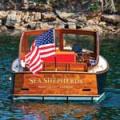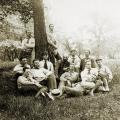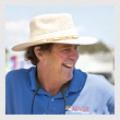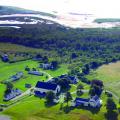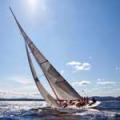Farrin’s Boatshop
“If It Floats, We Can Build It.”
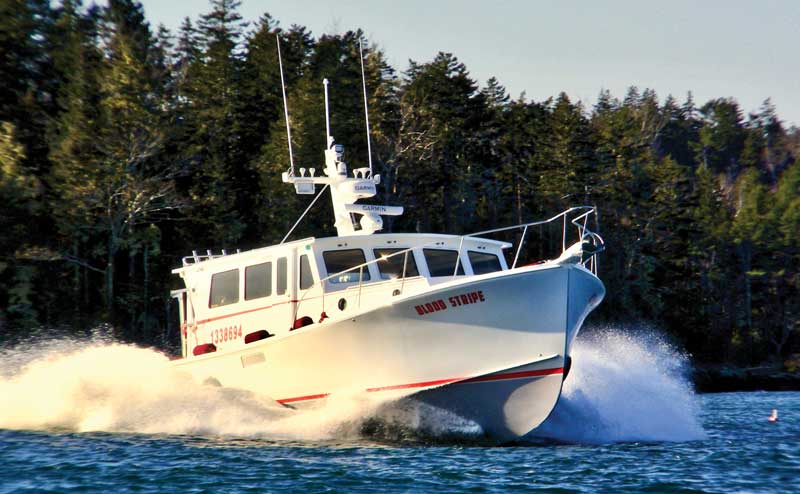 Chris Bumgarner’s 46-foot Mussel Ridge Blood Stripe has a top speed of 28 knots. Photo by Brian Robbins
Chris Bumgarner’s 46-foot Mussel Ridge Blood Stripe has a top speed of 28 knots. Photo by Brian Robbins
If there’s anything that Bruce Farrin Sr. has learned in his boatbuilding career, it’s that it pays to be willing to tackle whatever comes along for projects, be it finishing a tricked-out cruiser or diving into the bilge of a well-worked lobsterboat to replace its engine so it can get back out fishing.
2023 was a good example of that. Farrin and crew turned out a pair of workboat-style pleasure craft tailored to fit the needs of two boat-savvy owners.
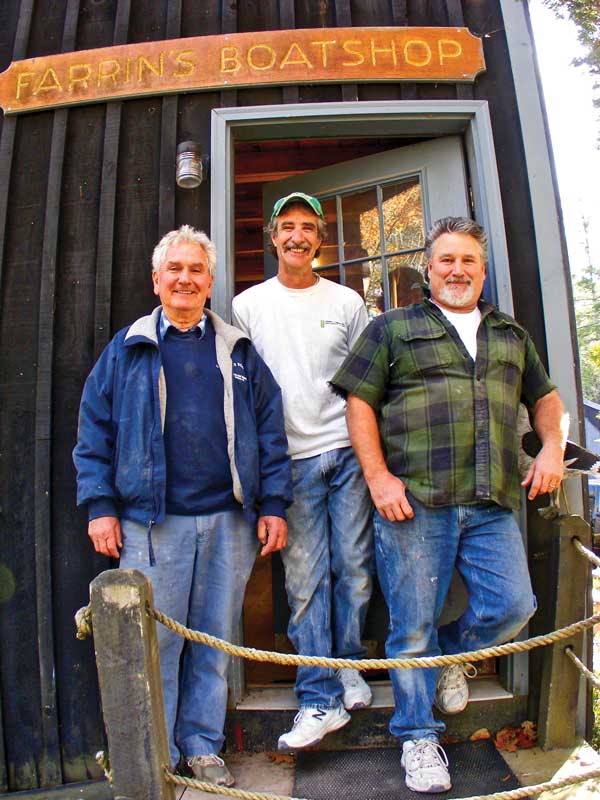 Left to right: Bruce Farrin Sr. and sons Brian and Bruce Jr. run the family business in South Bristol. Photo by Brian Robbins
It’s been 63 years since Bruce signed on at the Harvey F. Gamage Shipyard in South Bristol, where he hit the ground running, building heavy-duty wooden boats, which, during his tenure there, included numerous draggers, the Antarctic-bound research vessel Hero, and the well-known Hudson River-based sloop Clearwater.
Left to right: Bruce Farrin Sr. and sons Brian and Bruce Jr. run the family business in South Bristol. Photo by Brian Robbins
It’s been 63 years since Bruce signed on at the Harvey F. Gamage Shipyard in South Bristol, where he hit the ground running, building heavy-duty wooden boats, which, during his tenure there, included numerous draggers, the Antarctic-bound research vessel Hero, and the well-known Hudson River-based sloop Clearwater.
Over the next decade, Farrin slowly worked his way from the ground floor at Gamage’s to the top—or the top floor of the shop, anyway, where all the joinery work was done.
Those 10 years provided experience in the good, the bad, and the ugly of boatbuilding, and set Farrin up with the skills he needed to start his own shop in 1971, with the support of his wife, Judy, (“I couldn’t have done it without her,” he said) and two young sons, Bruce Jr. and Brian, to help out.
Over the years, building with wood eventually gave way to finishing fiberglass hulls from other builders, with the last from-scratch wooden boat rolling out of Farrin’s Boatshop in 1986. And in the meantime, brothers Brian and Bruce Jr. grew into the business as talented craftsmen themselves.
Ask the brothers separately what they feel they’ve learned from their father over the years, and you’ll get the same basic answers from each:
“Have a good work ethic.”
“Be dependable.”
“There’s no ‘close enough’—do it until you get it right.”
“Everybody does everything, from sweeping the floor to joinery work.”
“Take pride in what you do; a customer isn’t going to if you don’t.”
These days, Bruce Jr. and Brian are often focused on separate projects in the shop’s main bays, each leading their own crew.
“But when it comes to crunch time—getting ready to launch—everyone focuses on the same boat,” said Brian. “And we have a great crew who work well together.”
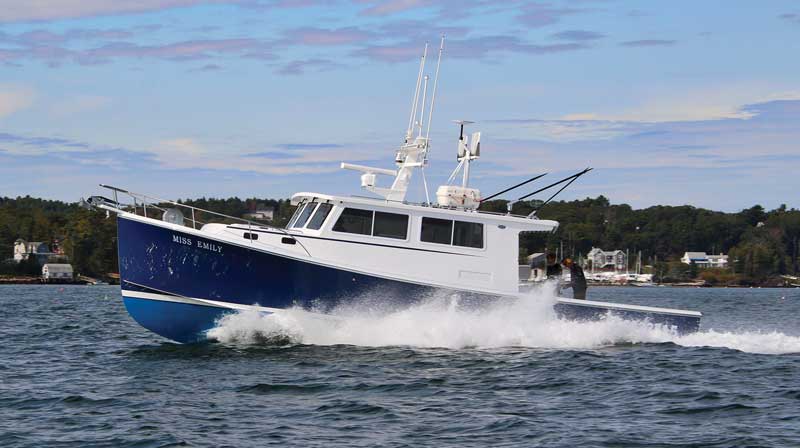 The 42-foot Miss Emily topped out at 26 knots during sea trials with a 21-knot cruise speed at 2,100 rpm. Photo courtesy Farrin’s Boatshop/Mike Morrison
The 42-foot Miss Emily topped out at 26 knots during sea trials with a 21-knot cruise speed at 2,100 rpm. Photo courtesy Farrin’s Boatshop/Mike Morrison
Which brings us back around to the way the Farrins have always been comfortable with both commercial fishing projects and the pleasure boating world. The uncertainties of the future of the New England fishing industry (due to proposed whale regulations, potential impacts of offshore wind development, and climate change in general) led to the cancellations of a couple of major lobsterboat projects in the last year. Fortunately, Farrin’s Boatshop was able to fill the voids with a pair of boats that are both examples of high-end finish work combined with workboat practicality.
The two customers—Tom McNulty Sr. of Cape May, New Jersey, and Chris Bumgarner of Ventura, California—not only come from different ends of the country; their respective histories on the water are quite different, as well.
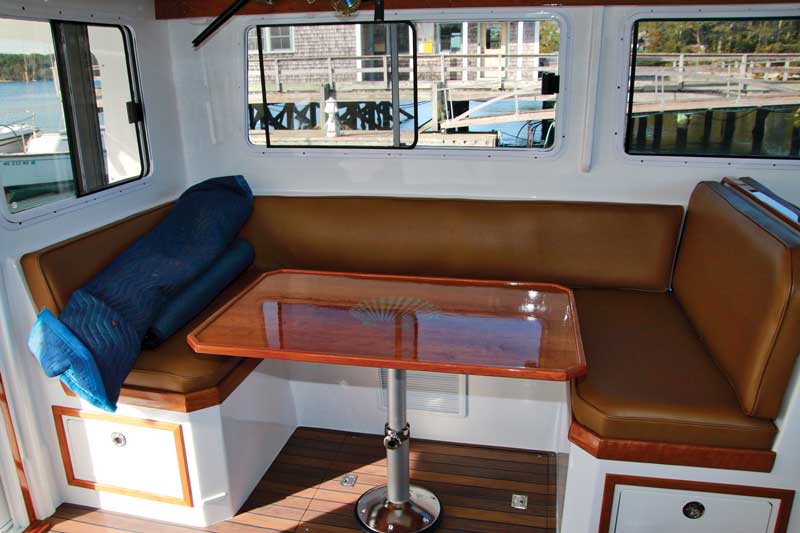 Photo courtesy Farrin’s Boatshop/Mike Morrison
Photo courtesy Farrin’s Boatshop/Mike Morrison
McNulty is well-known on the East Coast as a veteran scalloper with a multi-vessel fleet of draggers. Bumgarner, meanwhile, has family roots in the commercial fishing world, but he’s spent the last few years in a 26-foot outboard-powered boat when he wanted to get out on the water.
McNulty’s dream was to build himself a boat (smaller than the big steel scallopers he’s been used to) to just enjoy being out on the ocean and maybe do some charter fishing.
Bumgarner’s goal was to get into a boat big enough for the whole family to be comfortable, with his son Beckett (at 15, he is a fishing fanatic, and a talented one) likely to get into chartering when he gets a little older.
They may have started from different corners of the world, but the two ended up in Maine, each looking to have Hutchinson Composites in Cushing (creator of the Mussel Ridge models) build them a hull and molded top to be custom finished at Farrin’s Boatshop in Walpole.
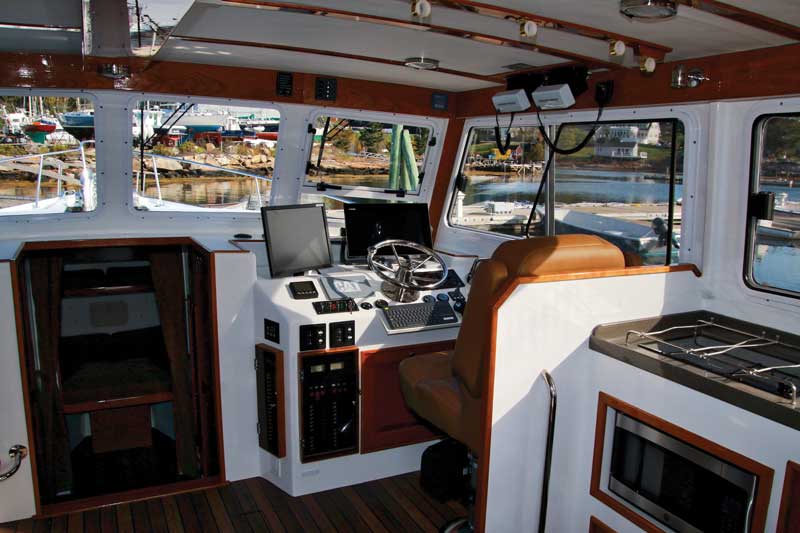 Miss Emily’s wheelhouse interior shows off Farrin's Boatshop's blend of workboat sensibility and yacht-worthy finish. Photo courtesy Farrin’s Boatshop/Mike Morrison
Miss Emily’s wheelhouse interior shows off Farrin's Boatshop's blend of workboat sensibility and yacht-worthy finish. Photo courtesy Farrin’s Boatshop/Mike Morrison
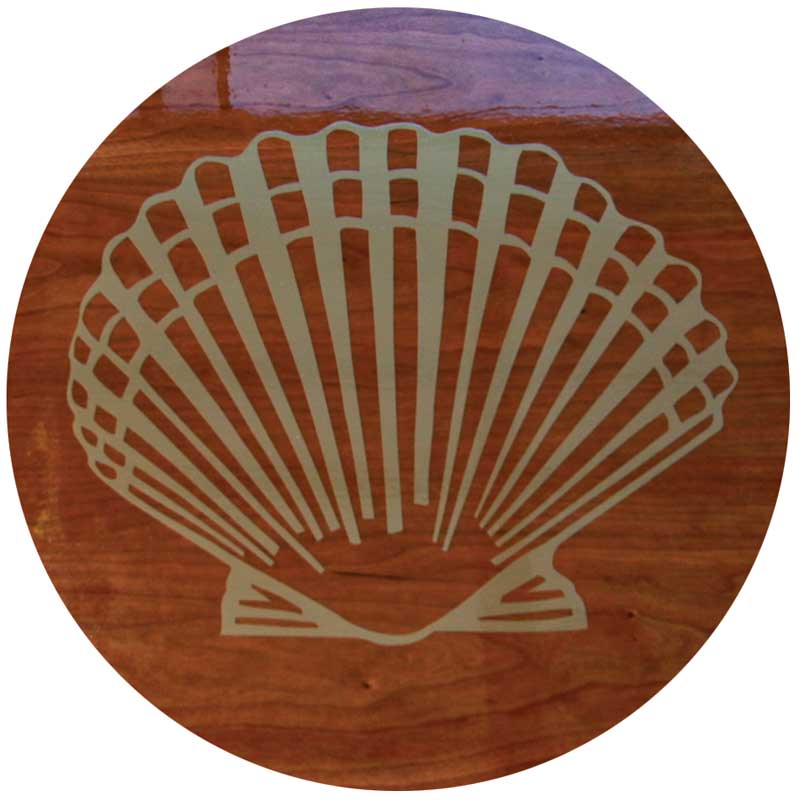 The scallop inlay on the dinette table in Miss Emily's wheelhouse is a nod to owner Tom McNulty Sr.’s “other life” as a scallop fleet owner/skipper. Photo courtesy Farrin’s Boatshop/Mike Morrison
McNulty’s choice of hulls was the Mussel Ridge 42, christened Miss Emily, while Bumgarner went with the 46, named Blood Stripe, which shares the same 15-foot beam as the 42 with an extra 4 feet of run on the aft end. Both models were designed by Tom Bernardi Jr.
The scallop inlay on the dinette table in Miss Emily's wheelhouse is a nod to owner Tom McNulty Sr.’s “other life” as a scallop fleet owner/skipper. Photo courtesy Farrin’s Boatshop/Mike Morrison
McNulty’s choice of hulls was the Mussel Ridge 42, christened Miss Emily, while Bumgarner went with the 46, named Blood Stripe, which shares the same 15-foot beam as the 42 with an extra 4 feet of run on the aft end. Both models were designed by Tom Bernardi Jr.
As they usually do, the younger Farrins each focused on a finish project with their own crew: Brian headed up the 42-footer job, while Bruce Jr. led the way on the 46.
Both generations of the Farrin family are particular about how they do things, which their customers appreciate. Part of that recipe is a list of familiar suppliers who they’ve worked well with over the years.
Billings Diesel is on that list, having supplied many power packages to the shop in the past. Billings is a dealer for several different engine brands; in this case, both boat owners wanted to go with C-18 Cats. The 42-footer’s Caterpillar was matched to a 2:1 Twin Disc MGX-5136A gear with EC300 electronic controls at both steering stations, while the C-18 for the 46 was paired up with a 2.19:1 ZF 500-1A with ZF’s own SmartCommand electronic control heads at each helm. Billings also furnished Humphree trim tabs for the pair.
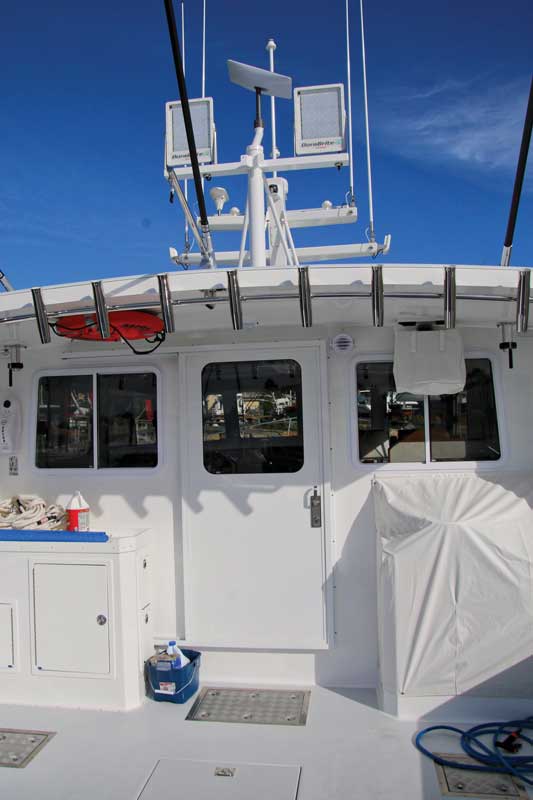 Miss Emily’s rod holders are lined up atop the wheelhouse and everything is ready for some serious fishing. Photo courtesy Farrin’s Boatshop/Mike Morrison
Miss Emily’s rod holders are lined up atop the wheelhouse and everything is ready for some serious fishing. Photo courtesy Farrin’s Boatshop/Mike Morrison
R.E. Thomas Marine Hardware built 3-inch drivelines for both projects, with Nautilus Marine channeling the Cats’ power to the water with 5-bladed propellers. McNulty’s Miss Emily was fitted with a 32 x 34 5-blader, while the little bit deeper ratio on Chris Bumgarner’s Blood Stripe allowed for a 34 x 36 5-blade wheel.
Other common suppliers between the two projects included Soundown (exhaust systems); Lonnie’s Hydraulics (components) and Billings & Cole (additional hydraulic components and installation of all the systems); Blue Water Fabrications (metal fab); Sawyer & Whitten Marine Electronics; and Fairwind Marine, which took care of the wiring chores on each boat.
“Beautiful finish work—with some heavy-duty workboat muscle,” summed up one observer.
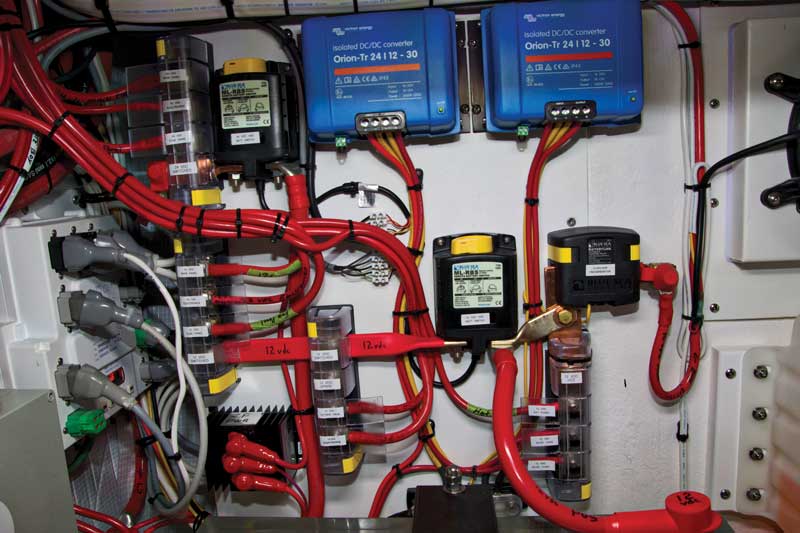 Both Blood Stripe (shown) and Miss Emily were wired by Troy Benner of Fairwind Marine. Photo courtesy Farrin’s Boatshop/Mike Morrison
Both Blood Stripe (shown) and Miss Emily were wired by Troy Benner of Fairwind Marine. Photo courtesy Farrin’s Boatshop/Mike Morrison
Some examples of that finish work and amenities aboard Miss Emily include a reverse osmosis watermaker, tuna tank, berths for four, a head with separate shower, a full suite of electronics including a Starlink satellite system, full galley with Corian counters and reverse air heat and air conditioning.
As the two crossover projects were rolled out of Farrin’s Boatshop, their places were taken by a Mitchell Cove 35 lobsterboat (originally finished by the Farrins 20 years ago) to be refurbished and repowered and a Calvin Beal 42 hull and top to be finished as a patrol vessel for the Maine Department of Marine Resources.
“Whatever it takes,” said Brian Farrin. “As long as we’re staying busy.”
✮
A former offshore lobsterman, Brian Robbins is senior contributing editor for Commercial Fisheries News.
Related Articles
Share this article:
2023 Maine Boat & Home Show

Join Us for the Maine Boat & Home Show!
Art, Artisans, Food, Fun & Boats, Boats, Boats
August 11 - 13, 2023 | On the waterfront, Rockland, Maine
Click here to pre-order your tickets.
Show is produced by Maine Boats, Homes & Harbors magazine.







